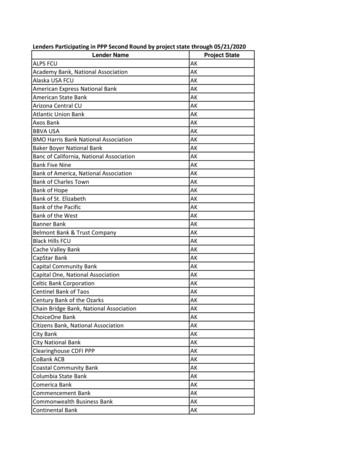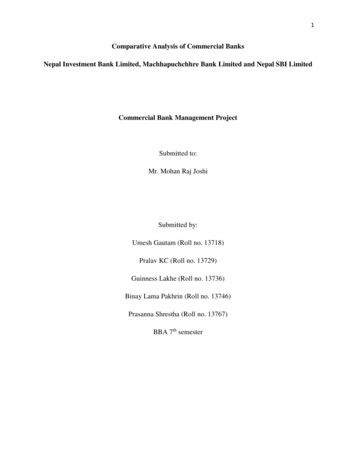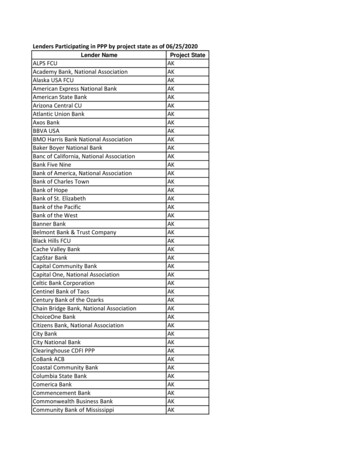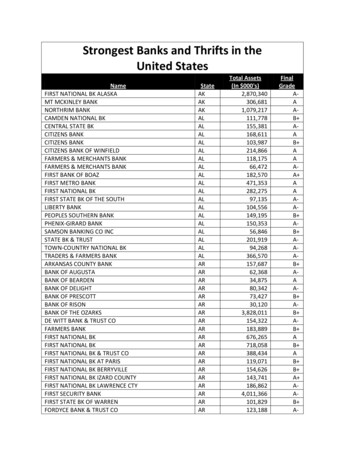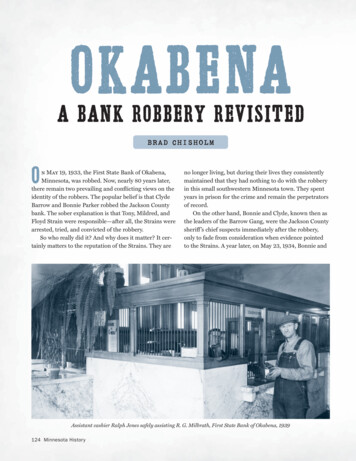
Transcription
OKABENAA BANK ROBBERY REVISITEDBRAD CHISHOLMOn May 19, 1933, the First State Bank of Okabena,Minnesota, was robbed. Now, nearly 80 years later,there remain two prevailing and conflicting views on theidentity of the robbers. The popular belief is that ClydeBarrow and Bonnie Parker robbed the Jackson Countybank. The sober explanation is that Tony, Mildred, andFloyd Strain were responsible—after all, the Strains werearrested, tried, and convicted of the robbery.So who really did it? And why does it matter? It certainly matters to the reputation of the Strains. They areno longer living, but during their lives they consistentlymaintained that they had nothing to do with the robberyin this small southwestern Minnesota town. They spentyears in prison for the crime and remain the perpetratorsof record.On the other hand, Bonnie and Clyde, known then asthe leaders of the Barrow Gang, were the Jackson Countysheriff ’s chief suspects immediately after the robbery,only to fade from consideration when evidence pointedto the Strains. A year later, on May 23, 1934, Bonnie andAssistant cashier Ralph Jones safely assisting R. G. Milbrath, First State Bank of Okabena, 1939124 Minnesota Histor y
Clyde were killed in a bloody roadside ambush. Shortlythereafter, two newly published accounts of their livesnamed Okabena as one of their crimes, but these biographies were soon discredited. Then, in the late 1990s,historians began attributing the Okabena robbery to theBarrow Gang once again. Two recent books, Jeff Guinn’sGo Down Together and Paul Schneider’s Bonnie andClyde: The Lives Behind the Legend, present Okabena asan uncontested Barrows crime. Guinn devotes only onesentence to the Strains, and Schneider makes no mentionof them whatsoever.1 Indeed, no one has ever told thestory of the Strains, yet their story is essential to answering the question: “Who robbed the bank at Okabena?”Okabena citizens who remember the robbery, as wellas descendants of witnesses and other guardians of thelocal history, are reluctant to accept that Bonnie andClyde (and Buck and Blanche Barrow) were the culprits.Their skepticism is understandable. They point out thatwhile it is tempting to believe that the local bank wasrobbed by history’s most famous outlaw couple, reasondictates otherwise. Local eyewitnesses identified theStrains, and local juries found them guilty. Yet for thepast several years, former Okabena resident John “Doc”Sievert has been staging good-natured reenactments ofthe bank robbery, replete with actors dressed as BonnieBrad Chisholm is a professor of film history at St. Cloud StateUniversity, the recipient of two awards for teaching excellence,and the author of numerous scholarly articles on the movingimage arts. Dr. Chisholm’s current work on depression-erabank robbery grew out of the research for his “History on Film”course and from a life-long fascination with the history of hisnative Minnesota. This article is an excerpt from his longerwork on the topic. Text copyright 2010 by Brad Chisholm.and Clyde, as part of the town’s Independence Day festivities.2 The reenactments stir up old debates over whodid it and, like this historical investigation, sometimestouch a nerve.The robbery itself was more complex than any publicperformance can readily convey. At approximately1 a.m. on Friday, May 19, 1933, two men broke into theOkabena bank through a rear window. When the bank’stwo employees came to work at 8 a.m., the intruders apprehended them at gunpoint. Over the next few minutes,six people entered the building, including two children,and all were made to lie down on the floor.3The gunmen stuffed their lootinto a bag and herded theircaptives into the basement.The gunmen forced assistant cashier Ralph Jones toopen the safe, from which they took nearly 1,400. Chiefcashier Sam Frederickson, from his prone position onthe floor, activated a “silent” alarm that was heard in thehardware store next door. Unaware of this, the gunmenstuffed their loot into a bag and herded their captives intothe basement. Outside, two young women in a black FordV8 sedan pulled up to the rear of the bank and honkedthe horn. The bandits exited through a back door andclimbed into the car. Just then, three shots rang out.4August Atz, proprietor of the adjacent hardwarestore, had fired a .32 pistol at the getaway car through anarrowly opened sliding door near the back of his building. He missed. The woman in the front passenger seat,Winter 2010–11 125
who witnesses described as having exceptionally brightred hair, fired a machine-gun burst in Atz’s direction, buthe ducked behind a heavy iron hardware cabinet and wasspared injury. The car sped off and drove in a six-blockarc through town, with the gun-wielding woman and thetwo men spraying the town with machine-gun fire thewhole way. Schoolchildren ducked behind trees. Bulletssliced through walls and shattered windows. Frederickson dialed the local telephone exchange (the 1930s equivalent of 911) just as a parting shot pierced the front of thebank and slammed into the ceiling above his head. Thebandits zoomed south out of town toward the Iowa border less than 20 miles away. It was all over by 8:15 a.m.and, remarkably, no one had been hurt.Schoolchildren ducked behindtrees. Bullets sliced throughwalls and shattered windows.Sheriff Chris Magnussen was in Jackson, 15 milessoutheast of Okabena, when he got the call. He drovesouth into Iowa and found a few people who had seen theblack Ford speed by, but the trail was lost in the vicinityof Spirit Lake. Nevertheless, his pursuit calls into question those cinematic depictions of depression-era lawmenwho stop chasing bandits at the state line.5By the time Magnussen got to Okabena, detectivesfrom the Minnesota Bureau of Criminal Apprehension (BCA) were already examining the crime sceneand taking statements. Agent William Conley, from theBCA’s Worthington office, had taken charge of the case.Magnussen drove back to his office in Jackson to reviewrecent alerts for any bandit gangs with female members—as rare then as they are now. He found one. Fiveweeks earlier, a gang that included two women had killedtwo police officers in a hellacious shootout in Joplin,Missouri. They escaped capture but were identified asthe Barrow Gang from personal effects they left behind,including cameras holding rolls of unprocessed film andthe handwritten poetry that would make Bonnie andClyde objects of public fascination.6Back in Okabena, Agent Conley was encouraged byeyewitness descriptions of the two male bandits thatseemed to correspond to the height, hair color, and complexions of two petty criminals, brothers Tony and FloydStrain. The Strains were believed to be members of a126 Minnesota Histor ybrazen Sioux Falls-based gang that since January hadravaged area banks: Canova, Huron, Kaylor, and Vermillion, South Dakota, as well as Chandler, Ihlen, Madison,Russell, and Westbrook, Minnesota. Minnesota wouldexperience 32 bank robberies in 1933, the most in its history until the modern proliferation of bank branches insuburbs and supermarkets helped push robbery numberspast depression-era levels. Bank robberies had been on therise nationally since 1920, spurred by the new prevalence ofautomobiles and paved highways that made fast getawayspossible, then compounded by economic hard times. In theearly 1930s, county sheriffs and state criminal-investigationagencies such as Minnesota’s BCA were the law enforcement entities charged with solving rural bank crimes. TheFederal Bureau of Investigation would not be granted anyjurisdiction over bank robberies until January 1934.7Minnesota’s BCA and South Dakota’s Criminal Investigation Division (CID) conducted a joint effort tocatch the Sioux Falls-area bank robbers. By the time ofthe Okabena heist, agents from both states had for somemonths been quietly focusing their attention on theStrains. Tony and Floyd had been born in Minnesota’sLac Qui Parle County and grew up across the state linein South Dakota’s Grant County. The eldest of ten farmchildren, they got caught stealing a load of grain from aneighbor in 1924, which earned them each a six-monthstretch in the South Dakota State Penitentiary. By 1933Tony, now 28, was living in Sioux City, Iowa, where hesupported himself and his wife Mildred, 24, by transporting liquor—illegally—for area bootleggers. Floyd, 29, wasliving in Milbank, South Dakota, having recently completed a second prison term, this time for abandoning hiswife and children.8On January 3, 1933, a car stolen from Milbank wasused in the robbery of the bank at Russell, Minnesota,70 miles to the southeast. The car was later returned tothe Milbank area and abandoned in a field. As one of thetown’s less reputable citizens, Floyd Strain came undersuspicion, but no hard evidence linked him to the stolencar or the Russell robbery. Minnesota and South Dakotaauthorities began to gather information about Floyd andTony from this point on.9A further reason to suspect the Strains presenteditself on April 13, 1933, when a witness to an attemptedbank robbery in Huron, South Dakota, identified TonyStrain from a mug shot. The Sioux City police were askedto detain Tony until the Huron witness could drive downand attempt an identification in person. Tony was pickedup and held for the legal limit of three days, but the wit-
Left: Young Tony Strain’s mug shot, 1924, from his time in South Dakota’s state penitentiary.Right: Floyd Strain, 1924, from his first stint in the South Dakota prison.ness failed to appear. Obliged to release Tony, detectivesnonetheless kept him under limited surveillance. Thenon May 15, just days before the Okabena robbery, Tonydisappeared. Floyd Strain was also missing from his Milbank residence. Later that day, law enforcement agenciesissued a warning to bankers in the Sioux Falls area to expect a robbery attempt within the week.10Indeed, the very next day the bank at Canova, SouthDakota—an hour’s drive from Sioux Falls—was robbed.And then, on May 19, Okabena. That afternoon, merehours after the robbery, Agent Conley and Sheriff Magnussen conferred with the Sioux City chief of detectives, TomGreen, as well as with CID agents in Sioux Falls. It musthave appeared to Conley and his colleagues that the Strainbrothers had embarked on their latest spree. Nevertheless,Magnussen called Joplin’s chief of detectives, Ed Portley,to learn more about the Barrow Gang. By the weekendof May 20–21, however, at least one of the Okabena witnesses had picked Tony’s picture out of a selection of mugshots, prompting Magnussen to drop the Barrows fromfurther consideration. On May 23, just four days later, awarrant was made out in Jackson County court chargingTony and Floyd Strain, along with a woman named “BelleMcLain” and another woman, name “as yet unknown,”with the robbery of the Okabena bank.11Within weeks, the three Strains were in custody.When Tony turned up at his home on May 29, the police were waiting for him. They arrested Mildred at thesame time, belatedly naming her as the remaining femalebandit. She was revealed to have spent time in prison forher involvement in a 1929 bank robbery with a previousboyfriend. Floyd was arrested in Sioux Falls on June 22in a police raid of a riding academy across the street fromthe area’s most notorious roadhouse. Only Belle McLain,described as Floyd’s red-haired female companion, remained at large.12Witnesses to every unsolved bank holdup in the region were escorted to the Sioux City jail to see Tony andto the sheriff ’s lockup in Sioux Falls to get a look at Floyd.The Strain brothers were soon identified as having participated in the robberies at Okabena, Westbrook, Ihlen,and Russell, Minnesota, as well as Vermillion, Kaylor,Huron, and Canova, South Dakota. No female banditswere observed at any of these, except Okabena, so MilWinter 2010–11 127
Who Was Mildred Strain?Mildred Strain went by a variety of names in her lifetime,not all of them legal or accurate. She was born Mildred Cosier in 1909. She helped boyfriend Freddie Dunn conceal the moneyhe stole from a bank in Eden, South Dakota, in November 1929. Arrested the next year, she was imprisonedin South Dakota under the name Mildred Dunn andwas regarded as Freddie’s common-law wife. Mildred met Tony Strain when they were both inmatesin the South Dakota State Penitentiary; at that time,women were held in a remote area of the men’sprison. (Tony was serving a second term, this time forstatutory rape). Released within a month of each other,they lived together as common-law spouses, and shebegan to call herself Mildred Strain. When she was arrested for the Okabena robbery in1933, the newspapers referred to her as Alice Martin,which reporters briefly thought was her name. She hadgiven it earlier when arrested for juvenile delinquency,not wishing friends and relatives to see her real nameon the police blotter. Occasionally, she was also calledStormy and signed at least one letter that way. A few years into her Okabenaprison stretch, she asked herwarden not to accept lettersfrom Tony any longer andreclaimed her original name,Mildred Cosier. Paroled from prison and freeof Tony Strain, she movedto Iowa and married a localman, ending her days in1974 as Mildred Gertz.Sources: Tony’s and Mildred’s prisonfiles; local newspapers. Capt. JohnBenting, South Dakota State Prison,e-mail to author, Aug. 29, 2008 (onhousing women in the penitentiary).Okabena Press, June 8,1933, using several ofMildred’s aliases128 Minnesota Histor ydred was only presented to witnesses to that crime. Whentwo of them, farmers D. B. Hovenden and Albert Sievert,admitted that Mildred looked like the driver of the getaway car, she was formally charged.13The Strains went before the jury in two sensationaltrials held at the stately hilltop courthouse inJackson. Mildred and Tony sat handcuffed together intheir September 1933 trial. No physical evidence waspresented, but eight local residents testified that thesewere two of the Okabena bandits. The court-appointeddefense attorney made little effort on their behalf. Tonyclaimed he was delivering illegal shipments of liquorto Rapid City the day of the robbery but had no one tovouch for him. Mildred’s and Tony’s landlady and a fellowboarder testified that Mildred was home the day of therobbery, but Sioux City police detectives Claude Bledsoeand Everett Smith took the stand and declared that Mildred’s alibi witnesses were part of a prostitution ring andtherefore not credible. The trial took a day and a half,and the jury needed only an hour to find Tony and Mildred guilty.14Floyd’s trial for the Okabena robbery did not occuruntil February 1936, as Hutchinson County, South Dakota, had won the right to try him first for the April 20,1933, bank robbery at Kaylor, at which a bystander waskilled. Five witnesses testified that Floyd was the getawaydriver. He was found guilty, but his conviction was overturned on appeal two years later because testimony supportive of his alibi had been improperly excluded. Floydwas released from prison in South Dakota only to beremanded to Minnesota, where he was tried for the Okabena robbery. Like his brother, he claimed to have beenon a Rapid City bootlegging run the day the bank wasrobbed. To no one’s surprise, the jury found him guilty.15Eyewitnesses had unhesitatingly identified Tony, Mildred, and Floyd as three of the four people they saw robthe Okabena bank. The fourth bandit, the elusive BelleMcLain, was never caught.Tony and Floyd were sentenced to 10-to-80 years inthe state prison at Stillwater. Mildred got 5-to-40 yearsin the women’s prison at Shakopee, a lighter sentence because, as the driver, she did not enter the bank or wield aweapon. All three maintained their innocence and, overthe years, engaged a number of attorneys to continue investigating the case, but to no avail. Mildred was parolednine years later, in 1942. Tony and Floyd were released in1946.16 In retrospect, the case against the brothers appearsto have been strong, but a close examination of the case
against Mildred (and the problem of the vanished BelleMcLain) calls into question whether the Strains could everhave been responsible for the Okabena robbery.Trial transcripts reveal that Mildred testified thatshe could not drive a car. Her landlady confirmedthis on the witness stand, citing a shopping-trip incidentthat was exacerbated by Mildred’s inability to drive thelandlady’s car. The jury ultimately disregarded this information.17Could the authorities have arrested the wrongwoman? Yes. Mildred was deliberately framed. She wasnot named in the initial warrant because detectives onthe lookout for Tony were watching her residence the dayof the Okabena robbery and were fully aware that Mildred was at home. These were Sioux City officers Bledsoeand Smith, the very pair whose testimony underminedMildred’s alibi witnesses. Sometime between the issuanceof the warrant and the arrest of Tony and Mildred, thesemen were pressured into withholding their knowledge ofMildred’s innocence, possibly under threat of exposurefor their role in a protection-money scheme. In 1936Bledsoe and Smith privately admitted their knowledge ofMildred’s innocence to one of her friends. They claimedto feel remorseful but helpless. They even visited her atCould the authorities have arrestedthe wrong woman? Yes. Mildredwas deliberately framed.the Shakopee prison.18 However, no surviving evidenceindicates that the detectives went on record about thecritical information they had withheld.What about the other woman named in the case—themysterious redhead, Belle McLain? Curiously, no photograph or biographical information about her was everpublished, yet newspaper readers saw plenty of such material on the Strains. Six weeks after the robbery, a prosecuting attorney revealed that Belle McLain was the aliasof a woman named Helen Roder. This news appearedin an off-handed mention in the fourth paragraph of aSioux Falls Daily Argus Leader article on Minnesota’s efforts to extradite Floyd Strain from South Dakota.19 Hadreporters followed up on this revelation, the mystery ofBelle McLain would have been quickly solved.Helen Roder was indeed a red-haired woman linkedto Floyd Strain. She had married him in 1925, had twoMildred Dunn, as she was called in the Women’s Departmentof the South Dakota state prison, 1930children, and then divorced him in 1931. Floyd was a twotiming, abusive husband, and Helen eventually had him arrested for child abandonment. By the time of the Okabenarobbery, she was remarried and living with her childrenand husband, Al Miller, in Minneapolis. The original warrant indicates that investigators believed Belle McLainalso went by the aliases Viola Stone and Bessie M. McCoy.Rather than being Helen’s aliases, Belle, Viola, and Bessiewere likely the names of various Floyd Strain associateshastily gathered during the early days of the investigation.Floyd was known as a man with many girlfriends.20Helen Roder had numerous relatives in the Milbankarea, so BCA agents would have had little trouble locatingher. They must soon have realized their error. Yet Conleyand his fellow agents allowed the public to believe thatBelle McLain was a fugitive whom they had little hope ofever capturing. Had they admitted the truth about eitherHelen or Mildred, they would have been unable to matchthe “Strain Gang” to the Okabena bandits. In May 1933,however, there was one active criminal gang consistingprecisely of two men and two women: the Barrows.Ayear after the Okabena robbery, Bonnie’s and Clyde’slives as fugitives came to a bloody conclusion.Graphic newspaper accounts of their deaths were quicklyfollowed by a series of True Detective magazine articlesWinter 2010–11 129
Left: Clyde Champion Barrow and his V-8 Ford, photo sent during his lifetime to the Minnesota Bureauof Criminal Apprehension. Right: Bonnie Parker, also from the history files of Minnesota’s BCA.and a ghost-written book attributed to Bonnie’s motherand Clyde’s sister, all claiming Okabena as a Barrow Gangrobbery. What these sources describe, however, is notOkabena, but the botched attempt at Lucerne, Indiana, aweek earlier. In that incident, Clyde and his brother Buckbroke into the bank at night. Buck’s wife, Blanche, withBonnie riding shotgun, drove up to the bank the nextmorning to pick them up. Two bank cashiers arrived forwork, but when Clyde and Buck tried to apprehend them,the men grabbed concealed weapons and thwarted therobbery. The Barrows got no money and were forced toflee. They raked the town with machine-gun fire as theysped away in their black Ford sedan.21Once it was determined that the hastily written bookand magazine series were confusing the Lucerne attemptwith the Okabena job, most crime historians dismissedthe claim that Bonnie and Clyde had robbed the bank atOkabena. That is, they did until John Neal Phillips’s biography of little-known Barrow associate Ralph Fults appeared in 1996. Fults told Phillips how on a wintry day inMarch 1932, he and Clyde Barrow drove through Okabenaand cased the bank with the intent to rob it. Icy road conditions made them change their minds, but Clyde wouldremember this vulnerable rural bank.22Then, in 2005, Phillips dazzled the Bonnie-and-Clyderesearch community with his edited version of BlancheBarrow’s previously unpublished, posthumous memoir.In it, Blanche described what we now clearly recognize asthe Lucerne robbery attempt of May 12, 1933, pointing130 Minnesota Histor yout that, because it failed, the gang had to rob anotherbank soon—they were short of money.23 One week later,the Okabena bank was robbed with the identical modusoperandi and by a quartet that exactly matched the description of the Lucerne bandits.The description of the gun-toting woman with unnaturally red hair also suggests that the Barrows were theOkabena bandits, not the Strains. News reports of the Okabena robbery used such phrases as “a brilliant hue of red.”At Tony and Mildred’s trial, witness Gus Seydel describedthe gunwoman as having “blond, red hair” that was “an awfully odd color.” Bonnie Parker, although born blonde, hadbeen periodically dying her hair red since January 1933.We know this from the account of a patrolman taken hostage on one of the Barrows’ trademark joy rides and froma black-and-white photograph of Bonnie from her fugitiveperiod, in which her hair is clearly not blonde. Two newsaccounts mention the female driver’s hair as well: one saidit was red, another said it was brunette. Blanche Barrow,who prided herself on her driving ability, had natural darkred hair. Mildred Strain’s hair was sandy brown.24Furthermore, the physical descriptions of the malerobbers more closely match up with Clyde and BuckBarrow than Tony and Floyd Strain. All the newspaperreports have the male bandits as thin, dark-haired, andbetween five-feet-five inches and five-seven. This describes the Barrow brothers and Tony equally well, butFloyd Strain was five-nine.25What became of Blanche and Buck? On July 24, 1933,
First State Bank of Okabenathey were captured by an Iowa posse. Buck, woundedprior to their capture, died a few days later. Blanche pledguilty to the attempted murder of a Missouri sheriff butadmitted little else. If either was ever asked about Okabena, we have no record of it, although Blanche’s memoirdescribed a robbery that editor Phillips believes is Okabena. Blanche never named the banks they robbed andwas ambiguous about dates, but much of her account ofthis robbery matches what we know of Okabena. For instance, she described how she and Bonnie, spending thenight in their car, endured a hailstorm while Clyde andBuck were holed up inside the bank. The hailstorm coincides perfectly with the weather reported for Okabenaand neighboring communities on May 19, 1933.26The description of the gun-totingwoman with unnaturally red hairalso suggests that the Barrowswere the Okabena bandits,not the Strains.Further evidence comes from an authenticated,unpublished manuscript written by Buck and Clyde’smother, Cumie Barrow. James R. Knight, coauthor ofBonnie and Clyde: A Twenty-First-Century Update,is one of the few scholars who has been permitted tosee this document, which remains in private hands.He reports that Cumie describes both the Lucerne andOkabena holdups accurately and by name, just as sheremembered her sons describing them to her at a secretfamily rendezvous in late May 1933.27Knight also notes that the model of car (Ford V8) andthe type of machine gun (Browning Automatic Rifle)used at Okabena were Clyde Barrow’s signature vehicleand weapon of choice. Clyde’s preference for the powerful, speedy Ford V8 is well documented. In 1933 that wasa distinctive, easily recognized car, recalled Calvin Paulson, who was walking to school when he saw the Okabena bandits roar by. And judging by the ease with whichshells pierced thick walls and doors in Okabena that day,the robbers were using Brownings. While the lighter,weaker Thompson submachine gun was more commonlyused by gangsters of the era, Clyde preferred the Browning for its penetrating force.28Yet eight eyewitnesses sat in a courtroom and sworethat Tony, Floyd, and Mildred Strain were the Okabena bank robbers. Even though Mildred was framedand Belle McLain was a phantom, were not Tony andFloyd members of the notorious gang that robbed a spateof banks in the Sioux Falls area? As a matter of fact, theywere not. The Minnesota State Prison inmate files contain the proof that there never was a Strain Gang. Therobberies that occurred near Sioux Falls in 1933 werelargely the work of three gangs unknown to the authorities until after the Strains were put in prison.Winter 2010–11 131
One of these was led by aSt. Cloud hoodlum named CyrilWooldridge. In January 1933, he andhis crew drove from central Minnesota to Milbank, South Dakota.There they stole a car, drove it toMILBANKRussell, Minnesota, relieved that(Grant Co.)community’s bank of 4,000, thenMADISONdrove back to Milbank, abandoned(Lac Qui Parle Co.)the stolen car, and returned to St.SOUTH DAKOTACloud. Wooldridge robbed sevenmore banks before he was caughtMINNESOTAin December 1933. He then gave afull accounting of his crimes andHURONco-conspirators, none of whom wereRUSSELL(Beadle Co.)(Lyon Co.)the Strains. It was the discovery ofthe Milbank car, used to divert susWESTBROOKpicion from Wooldridge’s St. Cloud(Cottonwood Co.)CHANDLER(Murray Co.)CANOVAIHLENhideout, that first drew attention(Miner Co.)(Pipestone Co.)to Floyd Strain, the ex-con living inOKABENA(Jackson Co.)Milbank with no visible means ofsupport. The Strain brothers appearSIOUX FALLS(Minnehaha Co.)never to have learned of Wooldridge’sinadvertent hand in their fate, evenIOWAthough they all did overlappingKAYLOR(Hutchinson Co.)stretches at Stillwater State Prison.29A second gang was led by a professional gambler from Omaha, RalphVERMILLION“Cap” Simpson. This group hit at least(Clay Co.)HOMETOWNsix banks in 1933. Then gang memberBANKFrank Kroy decided that prison andSIOUX CITY(Iowa)its three meals a day would be preferable to the hazards of armed robbery.Kroy confessed and named all the gang members and their Floyd Strain. These revelations also became part of therobberies. Among these was the Westbrook, Minnesota,Strains’ pardon appeals, but were once again dismissedbank job that had been attributed to the Strains. Kroy saidas having nothing to do with the Okabena case.31The eyewitnesses who identified the Strains as robthat he had never heard of the Strains. This informationbers of numerous banks—more than 20 people in all—did reach Tony’s and Floyd’s attorneys and became part ofan unsuccessful appeal to the Minnesota Board of Pardons. had been utterly mistaken. How could this be? Today’scriminologists know that eyewitnesses are wrong aBoard members considered the information irrelevantsince the Strains were doing time for Okabena, not forshocking amount of the time; a substantial body of literaWestbrook.30ture bears this out. Yet in the 1930s, eyewitness testiA third gang was led by a Rochester, Minnesota,mony from one’s neighbors was still the most persuasivehouse painter named Clair Ralph Gibson. He was caught evidence for any jury, and eyewitnesses can be quite inin 1937 after a five-year robbery career that involved 21sistent. For example, at Floyd Strain’s 1933 trial for thebanks. Among these were the remaining banks to whichKaylor robbery and murder, one eyewitness maintainedthe Strains had been linked: Vermillion, Huron, Canova,that Tony Strain was also one of the gunmen, even after itIhlen, and Kaylor. Gibson named his accomplices inwas pointed out to him that this crime occurred whileevery robbery. He did not know or work with Tony orTony was sitting in a Sioux City jail cell.32The “Strain Gang”Homes and Suspected Haunts132 Minnesota Histor y
Ralph Jones, standing between a customer (at his right) and Sam Frederickson, the bank’s president and chief cashier, 1939The identification process was far from perfect. In the1930s, police did not always conduct line-ups in whicha suspect stood next to others of similar complexion andbuild. Quite often, they paraded the accused, alone, beforea group of witnesses concealed behind a screen. A surviving appeal brief reveals that at least one of Floyd Strain’s“show-ups,” as they were called, was handled this way.33It is worth noting that a few of those who attendedthese show-ups declined to identify the Strains, includingone person from Okabena. Assistant cashier Ralph Jonescould not say with confidence that Tony and Floyd werethe robbers; however the prosecuting attorney at Floyd’s1936 trial got Jones to admit that neither could he saywith certainty that the Strains were not the robbers. Evenso, eight other people—his coworker, three bank customers, three passersby, and a gas-station attendant—tookthe witness stand and swore that the Strains were thebandits. Ultimately, the Strains were not helped by thefact that Floyd and
Tony, now 28, was living in Sioux City, Iowa, where he supported himself and his wife Mildred, 24, by transport-ing liquor—illegally—for area bootleggers. Floyd, 29, was living in Milbank, South Dakota, having recently com-pleted a second prison term, this time for abandoning his wife and children.8

